View in other NatureServe Network Field Guides
NatureServe
Montana
Utah
Wyoming
Idaho
Wisconsin
British Columbia
South Carolina
Yukon
California
New York
Sweetwater Milkvetch - Astragalus aretioides
Other Names:
Astragalus sericoleucus var. aretioides, Orophaca aretioides
State Rank Reason (see State Rank above)
Sweetwater milkvetch is a reginal regional endemic from Montana south through Wyoming to Colorado and Utah, known in Montana only from exposed ridges and outcrops in the Pryor Mountains / Bighorn Canyon area. Threats to the species' viability in Montana appear to be minimal. Trend data are unavailable.
- Details on Status Ranking and Review
Population Size
Score2 - Small: Generally 2,000-10,000 individuals.
Range Extent
Score2 - Regional or State Endemic or Small Montana Range: Generally restricted to an area <100,000 sq. miles (equivalent to 2/3 the size of Montana or less) or Montana contributes 50% or more of the species’ range or populations OR limited to 2-3 Sub-basins in Montana.
CommentSmall Montana range.
Area of Occupancy
Score2 - Low: Generally occurring in 4-10 Subwatersheds (6th Code HUC’s).
Environmental Specificity
Score1 - Moderate: Species is restricted to a specific habitat that is more widely distributed or to several restricted habitats and is typically dependent upon relatively unaltered, good-quality habitat (C Values of 5-7).
Trends
ScoreNA - Rank factor not assessed.
Threats
Score0-1 - Low to Medium.
Intrinsic Vulnerability
Score0-1 - Low to Moderate Vulnerability.
Raw Conservation Status Score
Score
7 to 9 total points scored out of a possible 16 (Rarity factors and threats only).
General Description
Sweetwater Milkvetch is a long-lived perennial with short, profusely branching stems that form mounded cushions which are 1-3 dm in diameter. The pinnately compound leaves are 6-15 mm long and have 3 narrowly lance-shaped leaflets and a prominent papery sheath around the petiole where it meets the stem. Foliage is densely covered with silky hairs. Pea-like, magenta flowers are paired on short stems among the leaves. The upper petal is 6-8 mm long and partly reflexed upwardly. The calyx is 3-4 mm long. Fruit pods are narrowly egg-shaped, 4-5 mm long, densely silky and hairy, and are usually hidden amongst the leaves.
This taxon has also been treated as A. sericoleucus (M.E. Jones) Barneby var. aretioides M.E. Jones.
Phenology
Flowering occurs mid-June to mid-July and extends into August under some conditions.
Diagnostic Characteristics
Sweetwater milkvetch belongs to a distinctive section of Astragalus recognized by leaves with three leaflets and a cushion-like growth form. Of these, Astragalus gilviflorus and A. hyalinus have larger, yellow flowers and a calyx tube longer than 5 mm. Astragalus barrii has a banner petal longer than 8 mm and is found on clay soils east of the Bighorn Mountains.
Species Range
Montana Range
Range Descriptions
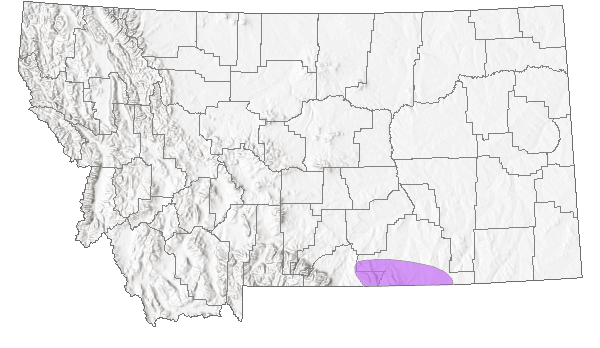
 Native
Native
Range Comments
MT south to CO; Big Horn and Carbon counties (Lesica et al. 2012. Manual of Montana Vascular Plants. BRIT Press. Fort Worth, TX).
Observations in Montana Natural Heritage Program Database
Number of Observations: 26
(Click on the following maps and charts to see full sized version)
Map Help and Descriptions
Relative Density
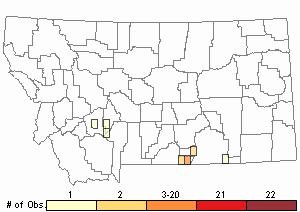
Recency
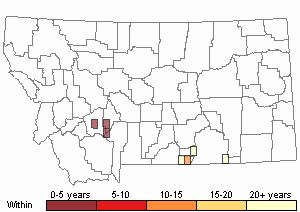

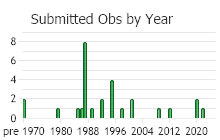
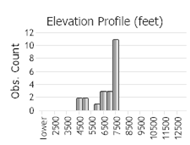 (Observations spanning multiple months or years are excluded from time charts)
(Observations spanning multiple months or years are excluded from time charts)
Habitat
Sweetwater milkvetch grows in the foothills and montane zone (about 4400-7800 feet) on exposed ridges and slopes in thin soil usually derived from limestone or calcareous sandstone. It typically occurs in openings of Douglas fir, growing with Eritrichium howardii, Shoshonea pulvinata, Petrophyton caespitosum, and Hymenoxys acaulis.
Ecology
Cushion plants with a woody caudex, such as Sweetwater milkvetch, are often long-lived and slow-growing (Ehrlen and Lehtila 2002). This plant grows on harsh sites with sparse vegetation and presumably minimal competition. The breeding system and pollinators are unknown, but legumes have a tendency to be outcrossers, requiring pollination to set fruit.
POLLINATORS The following animal species have been reported as pollinators of this plant species or its genus where their geographic ranges overlap:
Bombus vagans,
Bombus appositus,
Bombus auricomus,
Bombus bifarius,
Bombus borealis,
Bombus centralis,
Bombus fervidus,
Bombus flavifrons,
Bombus huntii,
Bombus mixtus,
Bombus nevadensis,
Bombus rufocinctus,
Bombus ternarius,
Bombus terricola,
Bombus occidentalis,
Bombus pensylvanicus,
Bombus griseocollis, and
Bombus insularis (Macior 1974, Thorp et al. 1983, Mayer et al. 2000, Colla and Dumesh 2010, Wilson et al. 2010, Koch et al. 2012, Miller-Struttmann and Galen 2014, Williams et al. 2014).
Management
This plant often grows in sites that are quite remote and/or not easily accessible, and most are on public lands. Wild horse trailing has been observed at some locations, but the impacts, if any, are unknown.
Stewardship Responsibility
Threats or Limiting Factors
STATE THREAT SCORE REASON
Threat impact not assigned because threats are not known (MTNHP Threat Assessment 2021).
References
- Literature Cited AboveLegend:
 View Online Publication
View Online Publication Colla, S.R. and S. Dumesh. 2010. The bumble bees of southern Ontario: notes on natural history and distribution. Journal of the Entomological Society of Ontario 141:39-68.
Colla, S.R. and S. Dumesh. 2010. The bumble bees of southern Ontario: notes on natural history and distribution. Journal of the Entomological Society of Ontario 141:39-68. Koch, J., J. Strange, and P. Williams. 2012. Bumble bees of the western United States. Washington, DC: USDA Forest Service, Pollinator Partnership. 143 p.
Koch, J., J. Strange, and P. Williams. 2012. Bumble bees of the western United States. Washington, DC: USDA Forest Service, Pollinator Partnership. 143 p. Lesica, P., M.T. Lavin, and P.F. Stickney. 2012. Manual of Montana Vascular Plants. Fort Worth, TX: BRIT Press. viii + 771 p.
Lesica, P., M.T. Lavin, and P.F. Stickney. 2012. Manual of Montana Vascular Plants. Fort Worth, TX: BRIT Press. viii + 771 p. Macior, L.M. 1974. Pollination ecology of the Front Range of the Colorado Rocky Mountains. Melanderia 15: 1-59.
Macior, L.M. 1974. Pollination ecology of the Front Range of the Colorado Rocky Mountains. Melanderia 15: 1-59. Mayer, D.F., E.R. Miliczky, B.F. Finnigan, and C.A. Johnson. 2000. The bee fauna (Hymenoptera: Apoidea) of southeastern Washington. Journal of the Entomological Society of British Columbia 97: 25-31.
Mayer, D.F., E.R. Miliczky, B.F. Finnigan, and C.A. Johnson. 2000. The bee fauna (Hymenoptera: Apoidea) of southeastern Washington. Journal of the Entomological Society of British Columbia 97: 25-31. Miller-Struttmann, N.E. and C. Galen. 2014. High-altitude multi-taskers: bumble bee food plant use broadens along an altitudinal productivity gradient. Oecologia 176:1033-1045.
Miller-Struttmann, N.E. and C. Galen. 2014. High-altitude multi-taskers: bumble bee food plant use broadens along an altitudinal productivity gradient. Oecologia 176:1033-1045. MTNHP Threat Assessment. 2021. State Threat Score Assignment and Assessment of Reported Threats from 2006 to 2021 for State-listed Vascular Plants. Botany Program, Montana Natural Heritage Program, Helena, Montana.
MTNHP Threat Assessment. 2021. State Threat Score Assignment and Assessment of Reported Threats from 2006 to 2021 for State-listed Vascular Plants. Botany Program, Montana Natural Heritage Program, Helena, Montana. Thorp, R.W., D.S. Horning, and L.L. Dunning. 1983. Bumble bees and cuckoo bumble bees of California (Hymenoptera: Apidae). Bulletin of the California Insect Survey 23:1-79.
Thorp, R.W., D.S. Horning, and L.L. Dunning. 1983. Bumble bees and cuckoo bumble bees of California (Hymenoptera: Apidae). Bulletin of the California Insect Survey 23:1-79. Williams, P., R. Thorp, L. Richardson, and S. Colla. 2014. Bumble Bees of North America. Princeton, NJ: Princeton University Press. 208 p.
Williams, P., R. Thorp, L. Richardson, and S. Colla. 2014. Bumble Bees of North America. Princeton, NJ: Princeton University Press. 208 p. Wilson, J.S., L.E. Wilson, L.D. Loftis, and T. Griswold. 2010. The montane bee fauna of north central Washington, USA, with floral associations. Western North American Naturalist 70(2): 198-207.
Wilson, J.S., L.E. Wilson, L.D. Loftis, and T. Griswold. 2010. The montane bee fauna of north central Washington, USA, with floral associations. Western North American Naturalist 70(2): 198-207.
- Additional ReferencesLegend:
 View Online Publication
View Online Publication
Do you know of a citation we're missing? Barneby, R. C. 1956. Pugillus Astragalorum XIX: Notes On A. Sericoleucus Gray and Its Immediate Relatives. Amer. Midl. Nat. 55: 504-507.
Barneby, R. C. 1956. Pugillus Astragalorum XIX: Notes On A. Sericoleucus Gray and Its Immediate Relatives. Amer. Midl. Nat. 55: 504-507. Barneby, R.C. 1964. Atlas of North American Astragalus. 2 Vols. New York Botanical Garden, Bronx, New York. 1188 pp.
Barneby, R.C. 1964. Atlas of North American Astragalus. 2 Vols. New York Botanical Garden, Bronx, New York. 1188 pp. Dorn, R.D. 1988. Vascular Plants of Wyoming. Mountain West Publ., Cheyenne.
Dorn, R.D. 1988. Vascular Plants of Wyoming. Mountain West Publ., Cheyenne. Ehrlen, J. and K. Lehtila. 2002. How perennial are perennial plants? Oikos 98: 308-322.
Ehrlen, J. and K. Lehtila. 2002. How perennial are perennial plants? Oikos 98: 308-322. Lesica, P., M.T. Lavin, and P.F. Stickney. 2022. Manual of Montana Vascular Plants, Second Edition. Fort Worth, TX: BRIT Press. viii + 779 p.
Lesica, P., M.T. Lavin, and P.F. Stickney. 2022. Manual of Montana Vascular Plants, Second Edition. Fort Worth, TX: BRIT Press. viii + 779 p. Skinner, K.F. 1995. Plant and grasshopper community composition: indicators & interactions across three spatial scales. M.Sc. Thesis. Bozeman, MT: Montana State University. 144 p.
Skinner, K.F. 1995. Plant and grasshopper community composition: indicators & interactions across three spatial scales. M.Sc. Thesis. Bozeman, MT: Montana State University. 144 p. Welsh, S.L, N.D. Atwood, S. Goodrich, and L.C. Higgins. 1993. A Utah Flora. 2nd edition, revised. Provo, UT: Brigham Young University. 986 p.
Welsh, S.L, N.D. Atwood, S. Goodrich, and L.C. Higgins. 1993. A Utah Flora. 2nd edition, revised. Provo, UT: Brigham Young University. 986 p.
- Web Search Engines for Articles on "Sweetwater Milkvetch"





